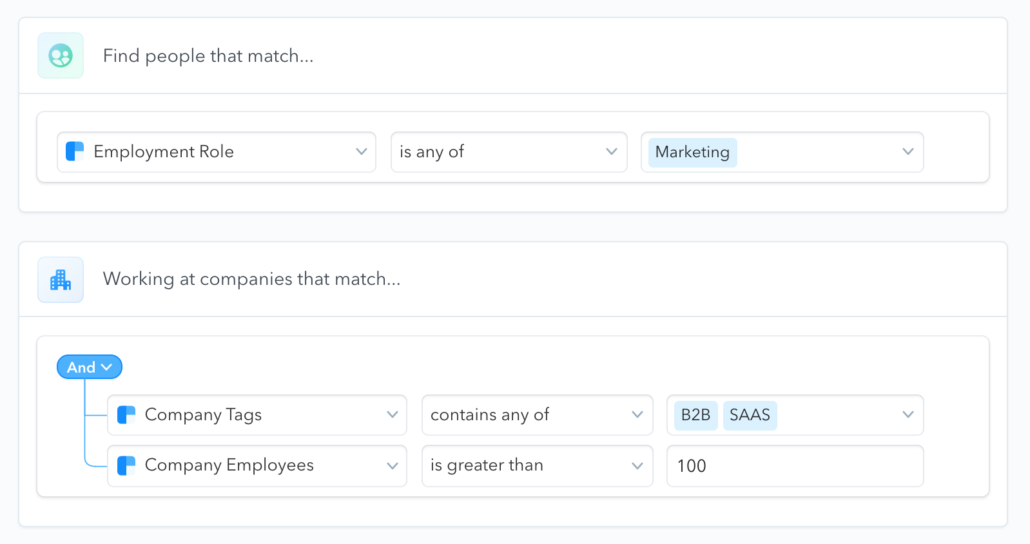How We Used Clearbit to Generate More Quality Leads for Thnks
As a growth agency, we run a lot of lead generation campaigns for our partners. Whether it’s B2B businesses looking to fill their pipeline or D2C brands building hype for a product launch, we’ve run lead gen every which way on every channel you can think of.
When we’re creating a growth marketing framework for these campaigns and thinking of what tactics to use, the question inevitably gets asked “Are we looking for quality or quantity with this strategy?”
Both.
The answer is both.
Of course, everyone wants a full pipeline of highly qualified leads for their sales team to feast on. Strong leads accompany more sales which leads to higher revenue. The issue is it’s never that simple. The typical tactics we look to employ here to generate leads usually sacrifice one of these areas. It is so difficult to generate leads at a high volume that are high quality at the same time. This is an issue we were having earlier this year with one of our partners, Thnks.
Thnks and Tuff
Thnks’ mission is to help establish and build stronger relationships through efficient, personalized, and thoughtful gestures of appreciation. Does that sound vague? That’s kind of the idea. Their platform allows you to send cups of coffee, a grab-and-go lunch, or an end-of-the-day cocktail to anyone’s email or phone with just a few clicks. The platform is very business-focused, seeing most of their traction coming from sales and HR professionals.
Thnks brought us on to help them bolster their lead pipeline and unlock a new avenue for growth through paid acquisition. They had seen some success in the past but wanted a team to bring some stability to their advertising channels as well as a strategy that helped these channels work together. When it came to lead generation efforts, we really only focused on two main social platforms:
- Facebook/Instagram
When it came to generating marketing qualified leads, we were only looking for companies of a certain size who we could expect to send a high volume of Thnks if converted to a customer. Thnks supports smaller businesses and individuals, but those customers don’t generate the same kind of LTV, so we decided against allocating budget to acquire these users at smaller companies.
Linkedin ads aren’t for every business, but they can be a really great place to generate leads depending on your product or service. With Thnks in mind, we saw a great opportunity to leverage their targeting options to isolate users who work in roles that are more likely to use Thnks and work at companies large enough for us to consider the lead“qualified.” Like I hinted at above, we were really looking for users who worked in sales or HR roles at worked at companies of a certain size.
Taking advantage of these targeting options has resulted in really efficient lead to MQL rates on Linkedin. Year to date at the time of writing our lead>MQL rate is sitting at 83%, which has been a huge factor in keeping our cost/MQL down on that platform. Unfortunately, we can’t say the same about our efforts on Facebook/Instagram.
Running ads on Facebook is an attractive option for B2B lead generation since the cost to deliver impressions and generate clicks on Linkedin is typically much more expensive. While clicks and impressions are generally cheaper on Facebook, you don’t get the same robust B2B targeting options that are accessible on Linkedin. Facebook offers some job title and industry targeting, but it’s nowhere near as accurate or reliable as what you can do on Linkedin.
Year to date at the time of writing, our lead>MQL rate is 48% for Facebook generated leads. When you put that number next to the 83% that we’ve seen on Linkedin, it immediately shows a gaping whole and huge opportunity for improvement on the Facebook front.
Now we just needed to figure out what can be done to improve our lead quality on Facebook. This number has such a huge impact on our overall cost per qualified lead, so any improvement we can find will go a long way in letting us hit our MQL goals.
How Clearbit was able to help
Working in digital advertising doesn’t mean I’m immune to ads. If anything I might be more susceptible to them since I can appreciate it when I get targeted with a good one. A few months ago I got hit with an ad from Clearbit offering to solve the exact problem that I was having with Thnks. I give their platform a ton of credit for being able to target me so well, but the creative (and yes, this is the exact ad I clicked on) was too relevant and enticing for me to ignore. I clicked through, did a little bit of research on the Clearbit website, and submitted a lead form requesting a time to chat with one of their sales reps.
What I learned on that call is that Clearbit was able to offer us the best of both Facebook and Linkedin advertising wrapped into one. By plugging their product into our Facebook ad account, we’ve been able to access “Linkedin level targeting” with our Facebook campaigns. This has allowed us to take advantage of the lower cost of delivery and clicks on Facebook while also isolating our highest qualified audience by industry, job title and company size.
This was exactly the solution we needed for our low lead>MQL rates from Facebook ads. That issue was directly caused by a lack of targeting options on Facebook, and Clearbit plugged that exact hole.
Results
As I mentioned above, we introduced Clearbit to our Facebook efforts in an attempt to increase our lead>MQL rates. We were happy with our cost per lead as reported in Facebook, but not enough of those leads were actually qualified. Thnks didn’t bring us on to generate a high number of bad leads, so paying close attention to the qualification rate has been super important to our partnership.
It took a couple weeks for Clearbit to really hit stride, but since then the numbers really speak for themselves. We’ve seen a huge improvement in our lead qualification rate when looking at Clearbit campaigns vs. non-Clearbit campaigns.
This is the exact result we were hoping to see when introducing Clearbit. We’ve seen a monumental improvement in our qualified lead rate with these new campaigns, which has helped us drop our cost/qualified lead while getting more high quality leads in the door. The results so far have been incredibly promising and we’re excited to continue using this tool with Thnks and other B2B partners we work with.
“I view our partnership with Tuff as more like an extension of my team. We strategize together, ask tough questions, examine the results, optimize – and it just keeps getting better. Exactly what I was looking for.” – Brad Veach, VP of Marketing at Thnks (see all Google Reviews for Tuff)
Conclusion
Getting Clearbit onboard was not the most straightforward test I’ve ever run for a partner. It required multiple calls with our point of contact at Thnks, calls with the reps at Clearbit, negotiations back and forth, and some onboarding for the platform itself. It was complicated, but the end results were more than worth it.
Despite the complexity, the thinking that went behind it is pretty standard for how we tackle testing and optimizations for our partners. We followed the steps Growth Marketers always take when introducing a new tactic:
- Isolate a problem metric you’re looking to improve (Our lead to MQL rate is holding us back)
- Find the root cause of the problem (Facebook targeting options are not as robust and accurate as we need)
- Put a plan in place to address the problem (Clearbit gives us the targeting options needed to drive more qualified leads)
- Execute and analyze results (Our lead qualification rate for Clearbit campaigns is 61% higher than non-Clearbit campaigns)
If you’re interested in exploring this type of testing framework and talking through some solutions we can offer to help your user acquisition, give us a holler! We’d love to talk.

Hi there! I’m Ethan, a Growth Marketer based in Steamboat Springs, Colorado. I have four years of digital agency experience under my belt creating and executing acquisition strategies for a number of different verticals across multiple channels. When I’m not at my desk, you can find me skiing, mountain biking, or chasing my dog around in the mountains.








